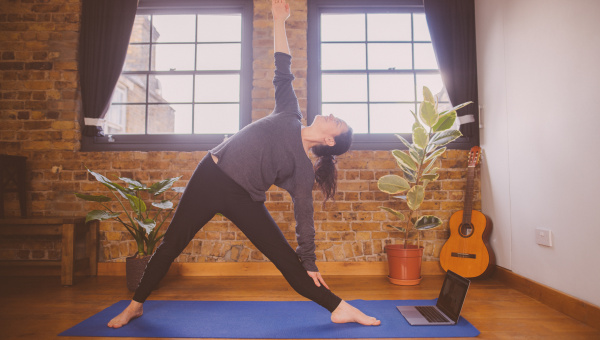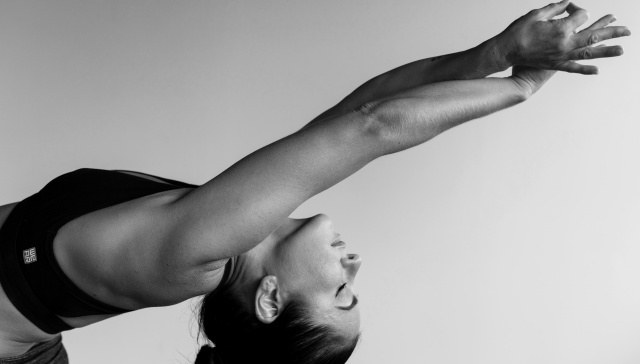Yoga poses
Yoga poses are usually split into 5 categories: forward bends, backbends, standing poses, inversions and twists. Read on to find out the history of yoga poses, the Sanskrit and English versions of name poses, the best poses for beginners, the best poses for practising with a partner or with a wall, and recommended poses for weight loss, for sleep and other conditions like back pain or constipation!
The first known yoga pose
The first sign of anything that resembled what we now think of as yoga pose was an emblem called the Pashupati seal: a man sitting in padmasana (lotus position: legs crossed with ankles by hip creases), wearing a striped tunic, a mask, and a huge headdress in the shape of two large horns.
The Pashupati seal was created in the Indus Valley in around 6500 BCE, a period known as the Pre-Vedic Age. This encompassed the time period before the written word or traditionally recognized religions such as Hinduism came about, at a time in human history when we were connected (or united) with nature in a way that sometimes feels foreign to us city-dwellers.
In fact, the Sanskrit word yoga translates to unify—referring to the state of yoga or “unification” of the whole self. Postural practices, or “asanas”, can bring about an experience of yoga, yet they are only some of the ways to experience unity of mind, body and spirit.
Also known as yoga poses, asanas—are utilised to bring health, flexibility and focus through physical discipline. With hundreds of variations, there is an almost limitless variety of postures to string together. Different yoga styles execute these poses in diverse ways. Some advocate moving quickly from one to the next (Ashtanga-Vinyasa); others stress the precision of slow movement and sustained stretches (Yin). Some styles include jumping, others include intensive breathing practices. Let’s unpack them in this article.
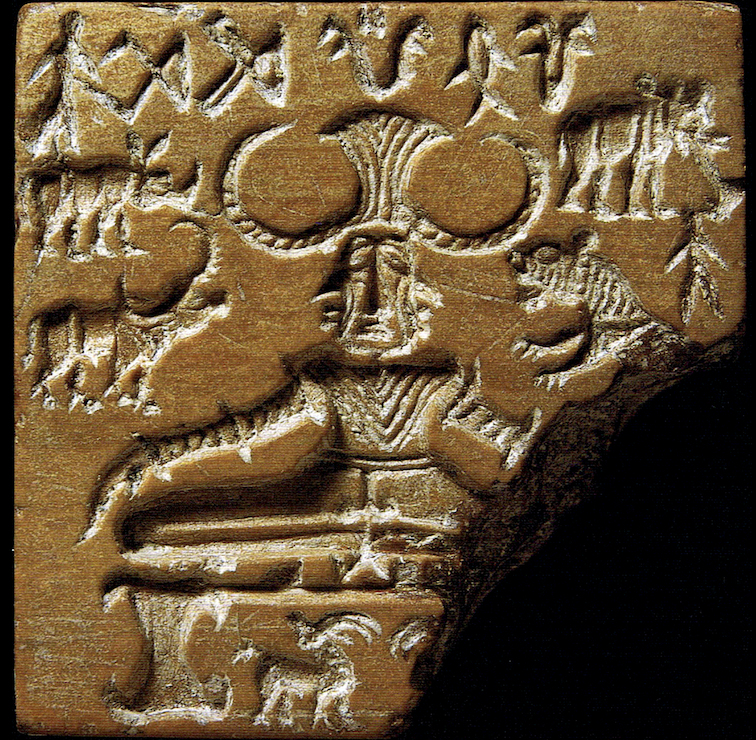
Names of Yoga Poses
Yoga poses often carry both Sanskrit and English names. Generally, the translations are correct and well adapted, but there are instances where multiple English names exist for the same pose, such as "Reverse Table" and "Upward Plank." This can be attributed to variations in teaching styles and traditions.
Many yoga poses are also named after animals, a reflection of the ancient practice of mimicking the natural world. For example, "Downward-Facing Dog" and "Cobra" are common animal-inspired poses. The reasoning behind these names is rooted in the belief that imitating animals helps practitioners embody specific qualities and benefits associated with those creatures.
In India, the names and stories behind the asanas might be as familiar as Robin Hood’s stories in the West. The asanas often encapsulate the attributes of legendary heroes, gods, and sages from Indian mythology. For instance, the warrior poses (Virabhadrasana) are named after Virabhadra, a fierce warrior created from Shiva's hair. This pose embodies strength and determination, encouraging practitioners to cultivate the warrior spirit.
The mythological origins of these names add a cultural and spiritual dimension to yoga practice. Understanding the stories and symbolism behind the asanas can deepen one’s appreciation and connection to the practice.
Do all yoga types use the same poses?
Not all yoga types use the same poses. For example, Iyengar doesn't include cat/cow poses or the Wild Thing pose, but has many inversions and uses a lot of props such as belts, blocks, and blankets to perform poses correctly. Shoulder stand, for example, can only be practised with a support under the shoulders. In Iyengar yoga, the type of poses follow the "Pune schedule": in week 1, you have standing poses; in week 2, twists and/or forward bends; in week 3, backbends; and in week 4, pranayama.
Meanwhile, Ashtanga follows the same sequence every day, and Vinyasa focuses on flow between poses and sun salutations. Yin yoga doesn’t feature any standing poses.
Most famous yoga poses
Triangle Pose (Trikonasana)
“One pose I enjoy practising is triangle pose, because I feel both grounded and expansive,” says Liz Stillwaggon Swan, author of Yoga ‐ Philosophy for Everyone. “And, because the body has memory, when I’m in a stressful situation… the act of recalling myself in triangle elicits in me the same positive feelings I experience when I’m actually in the pose.”
Part of many yoga sequences, the Triangle pose helps build strength in the legs and stretches the spine, hips, shoulders, groin, hamstrings, calves and chest.
How: Step your left foot back taking a wide stance. With your feet three and a half to four feet apart, turn your left foot slightly to the right as your right foot points to the top edge. Your front heel should be in line with the arch of your back foot. Firm your thighs and make sure the centre of the right knee is in line with the centre of the right ankle. Exhale and reach your right arm to the right, lengthening your torso directly over the right leg as you move your hips to the left. Rest your right hand on your shin, ankle, or floor outside your right foot keeping the sides of the torso long. Stretch your left arm toward the ceiling, in line with the tops of your shoulders. Keep your head in a neutral position or gaze beyond the left thumb. Try the other side.
The Downward-Facing Dog (Adho Mukha Svanasana)
The Downard-Facing Dog pose stretches the back of the legs, buttocks, back muscles, shoulders, and neck. It strengthens and stretches the wrists and arms, making it a perfect all-around posture that elongates, relaxes, but also strengthens almost every part of your body.
How: Start on all fours, hands under shoulders, knees under hips. Move your hands forward slightly. Inhale, lift your hips, straighten your legs, and keep your back, neck, and arms aligned. Exhale, drop your heels to the floor, feeling the stretch in the Achilles tendons and calves.
Warrior II (Virabhadrasana II)
Warrior II is a foundational pose that builds strength, stability, and openness. It stretches the hips, groin, spine, chest, and shoulders, while strengthening the feet, legs, buttocks, core, and shoulders. Modify by widening your stance and deepening the front knee for added challenge. This pose fosters peaceful courage and clarity.
How: Step your feet wide apart, align the front heel with the back arch. Rotate the front leg forward, stack the knee over the ankle. Inhale, stretch your arms out parallel to the ground, palms up. Focus on your front hand, breathe evenly. Repeat on the other side.
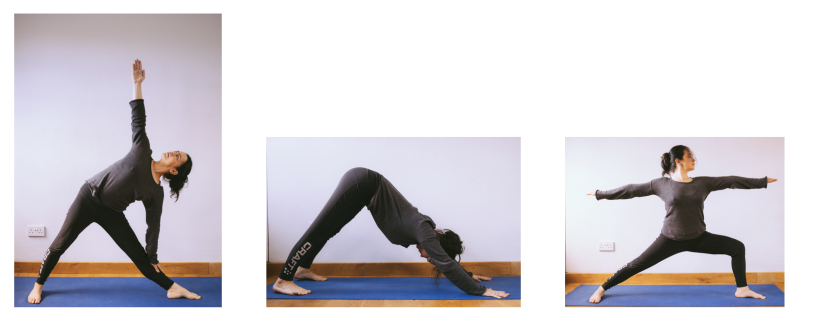
Fun yoga poses
Try flexible poses like Padmasana (Lotus Pose) to challenge flexibility in the joints of your hips, knees, and ankles. Happy Baby Pose is more playful, while Wild Thing, Warrior 3, or the Half moon pose flips things around in a way that challenges your balance.
Warrior 3 Pose (Virabhadrasana 3 )
Considered one of the more advanced standing and balancing postures, Vira 3 builds strength, stability, and courage. Modify it for focus and balance by placing the heel of the lifted leg against the wall. This pose embodies fearlessness and is a preparatory step for a Supported Handstand. It stretches the back leg, hips, buttocks, spine, chest, and shoulders, creating space in the lower back. It strengthens the feet, legs, buttocks, outer hips, spine, core, lungs, heart, and shoulders, supporting focus, stamina, and confidence.
Yoga poses for beginners
Choosing the right type of yoga depends on your fitness level and flexibility.
If you are fit but not flexible, opt for styles like Iyengar Yoga, which uses props to adapt poses, or a slower type like Hatha Yoga to improve flexibility gradually and safely.
For those who like energetic flows, Vinyasa Yoga is a great choice. This style incorporates cardio with sun salutations and dynamic pose transitions.
If you are a beginner, it is essential that you join beginner's classes to learn poses progressively. It wouldn't be very safe to do headstands before building core and strength - which is why you can only practice that pose in year 2! Here is a selection of beginners poses:
Tree Pose (Vrikshasana)
Starting in Mountain Pose, lift one foot, placing the heel on the opposite ankle, calf, or above the knee. Focus on an unmoving object to aid balance. Closing your eyes can reveal the mind's chaos, as the pose's stability comes from visual focus. Using visualisation techniques, such as imagining a stalk through your body's central axis, can help maintain balance even with closed eyes.
Tabletop Alternate Arm and Leg Balance (Dandayamana Bharmanasana)
This pose stabilises the core and spine while calming the mind. It's adaptable, making it suitable for all practitioners. By holding and pressing longer, or practising it supine, you can adjust its difficulty. This posture also supports cognitive function and can prepare the mind for meditation.
Child’s Pose (Bālāsana)
This comforting floor posture rests your back and legs, releasing and relaxing your body.
How: Start on all fours, sit back on your calves. Exhale, bend at the hips, stretch your arms forward with palms on the floor, and rest your forehead gently on the floor. Hold as long as comfortable, then inhale as you return to the starting position.
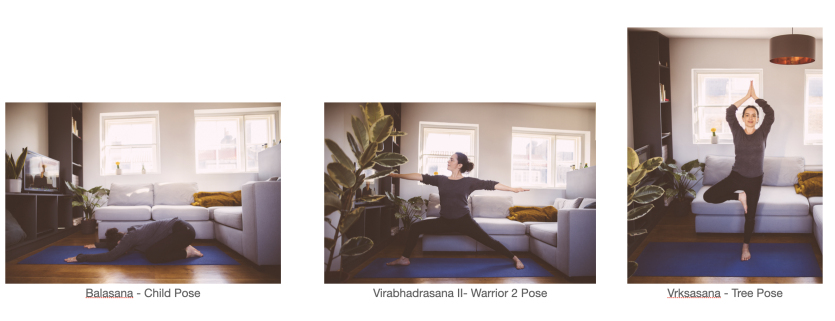
Yoga poses for 2
Yoga poses for two people can be a fun and bonding experience. For beginners, try these easy poses: Boat Pose with the soles of your feet pressing against each other, Twin Trees, or Seated Twist.
For more advanced practitioners who enjoy an acrobatic challenge, attempt the Flying Bow, Double Plank, and Partner Handstand.
Yoga poses for weight loss
Because yoga includes physical exercises that look like gymnastics and have even been incorporated into Western gymnastics, these postural exercises can help you to become or stay fit and trim, controlling your weight also by reducing your stress levels.
Yoga continues to gain acceptance within the medical establishment; more and more physicians are recommending it not only for stress reduction but also for physical therapy, notably on the back and knees.
- Yogi Sit-Ups: Strengthen the abdomen by lying on your back with your knees bent. Perform sit-ups, engaging your core muscles.
- Sun Salutations: This sequence of poses increases heart rate and includes various abdominal strengthening poses.
- Chair Pose: Strengthens the thighs and core, helping to build muscle and burn calories.
Seated chair yoga poses
Poses than can be practised while seated - chair yoga or desk yoga poses
- Seated Pigeon: Sit upright in your chair with both feet flat on the floor. Lift your right foot and place your right ankle over your left knee. Keep your right foot flexed to protect the knee. Gently press down on your right knee to deepen the stretch in your hip. Hold for several breaths, then switch sides.
- Seated Camel: Sit on the edge of the chair with your feet flat on the floor. Place your hands on your lower back or the back of the chair for support. Inhale, lift your chest, and gently arch your back, looking up towards the ceiling. Hold for a few breaths, feeling a stretch in your chest and front body. Return to an upright position slowly.
- Seated Twist: Sit upright with your feet flat on the floor. Place your right hand on the back of the chair and your left hand on your right thigh. Inhale, lengthen your spine, and exhale, twist your torso to the right. Hold for several breaths, then switch sides.
- Seated Forward Bend: Sit with your feet hip-width apart and flat on the floor. Inhale, lengthen your spine, and exhale, fold forward from your hips, bringing your chest towards your thighs. Let your hands rest on the floor or your shins, relaxing your neck and shoulders. Hold for a few breaths and then slowly rise back up.
Yoga poses for back pain
Yoga can help alleviate back pain with the right poses.
Good for Back Pain:
- Child’s Pose: Gently stretches the lower back.
- Cat-Cow Pose: Improves flexibility and relieves tension in the spine.
- Bridge Pose: Strengthens the back and glutes.
Avoid with Lower Back Weakness:
- Forward Bends: Can strain the lower back.
- Twisting Poses: May aggravate back pain.
- Full Wheel Pose: Intense backbends can be harmful.
For those with sciatica, these gentle stretches can help alleviate discomfort while avoiding poses that strain the lower back.
Wall yoga poses
- Supported Handstand (Adho Mukha Vriksasana): Place your hands where your feet were in Downward-Facing Dog, with heels against the wall. Spread your fingers and anchor the weight into the thumb and index finger. Firm the forearms and outer upper arms to stabilise the shoulders. Stack the shoulders over the wrists and look slightly forward. Step one foot up the wall, then the other, into a handstand. Hold, then slowly return to Child’s Pose.
- Warrior at the Wall (Virabhadrasana II Variation): Stand with your back against the wall, feet wide apart. Turn your right foot out and bend the knee to a 90-degree angle, keeping the left leg straight. Press your back and arms into the wall for support. Hold, then switch sides.
- Standing Spread-Legged Forward Bend at the Wall: Stand with your back against the wall, feet wide apart. Inhale, lengthen your spine, and exhale, fold forward from the hips, bringing your hands to the floor or a block. Press your back against the wall for support and hold the pose.
Yoga poses for sleep
Yogic Sleep is a very powerful relaxation technique that you can do through Yoga Nidra. To induce it, you must listen to a set of instructions, similar to a guided meditation. This can be in the form of a friend reading the instructions, or a recording. One feature of this practice is to focus in relatively quick succession on individual parts of the body. Mentally name each part and then sense it as distinctly as possible.
Practising Yoga Nidra before sleep is best because it’s an excellent technique for inducing lucid dreaming, the kind in which you’re aware.
How: Choose a clear intention and lie flat on your back, with your arms stretched out by your side. You may place a pillow or folded blanket behind your neck and another under your knees. Close your eyes, repeat the intention three times and take deep breaths. Rotate your awareness through all parts of the body on each side, limb by limb, tapping into your awareness. Repeat the rotation in the opposite direction. Repeat until you feel stillness and peace. Return to your initial intention three times. Mentally prepare to return to ordinary consciousness, and gently move your fingers, take a deep breath, then open your eyes.
Yoga poses for constipation & wind
- Wind-Relieving Pose (Pavanamuktasana): Lie on your back and bring your knees to your chest. Hug your knees and gently rock side to side. This pose helps stimulate digestion and release trapped gas.
- Seated Forward Bend (Paschimottanasana): Sit with your legs extended in front of you. Inhale, lengthen your spine, and exhale, fold forward, reaching for your feet. This pose massages the abdominal organs.
- Supine Twist (Supta Matsyendrasana): Lie on your back with your arms extended out to the sides. Bend your knees and drop them to one side, keeping your shoulders on the floor. Hold for several breaths, then switch sides. Twisting helps stimulate the digestive system.
Common Yoga Poses: Names in Sanskrit
Sanskrit Name | English Name |
Adho Mukha Svanasana | Downward-Facing Dog |
Virabhadrasana I | |
Virabhadrasana II | Warrior II |
Virabhadrasana III | Warrior III |
Vrksasana | Tree Pose |
Tadasana | Mountain Pose |
Uttanasana | Standing Forward Bend |
Utkatasana | Chair Pose |
Ardha Chandrasana | Half Moon Pose |
Garudasana | Eagle Pose |
Natarajasana | Lord of the Dance Pose |
Trikonasana | Triangle Pose |
Parsvottanasana | Pyramid Pose |
Bhujangasana | Cobra Pose |
Urdhva Mukha Svanasana | Upward-Facing Dog |
Dhanurasana | Bow Pose |
Salabhasana | Locust Pose |
Setu Bandhasana | Bridge Pose |
Ustrasana | Camel Pose |
Marichyasana | Sage Twist |
Ardha Matsyendrasana | Half Lord of the Fishes Pose |
Bakasana | Crow Pose |
Sirsasana | Headstand |
Sarvangasana | Shoulder Stand |
Halasana | Plow Pose |
Savasana | Corpse Pose |
Is there an official guide for yoga poses?
The most comprehensive and authoritative guide for yoga poses is "Light on Yoga" by B.K.S. Iyengar. This detailed catalogue of asanas includes sections on philosophy, practice, and beginner sequences.
Although extensive and ideal for reference, beginners might find "Ashtanga Yoga: The Practice Manual" by David Swenson more practical. Another excellent recommendation is "Asana Pranayama Mudra Bandha" by Swami Satyananda, which covers more than just asanas and is suitable for both beginners and advanced students.
Additionally, "Science of Yoga" by Ann Swanson provides a detailed, scientific approach to yoga, making it a valuable resource for understanding the physiological benefits of various poses.
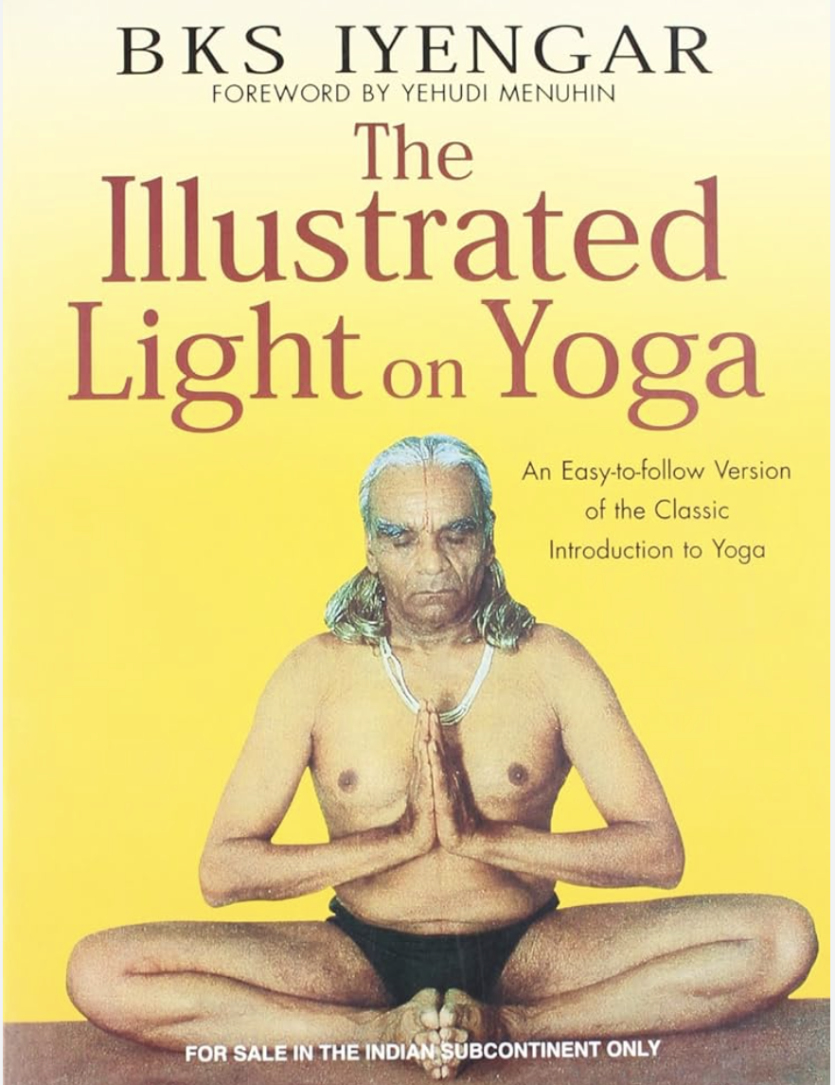
 Live Yoga Teachers
Live Yoga Teachers

